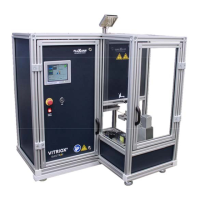
Do you have a question about the FLUXANA VITRIOX ELECTRIC and is the answer not in the manual?
| Application | Elemental analysis of solid, liquid, and powder samples |
|---|---|
| Elements Range | From Sodium (Na) to Uranium (U) |
| Sample Types | Solids, liquids, powders |
| Detector | Silicon Drift Detector (SDD) |
| Dimensions | 600 x 600 x 700 mm |
| Detection Limits | ppm to percentage levels depending on the element and matrix |
Detailed description of the VITRIOX® ELECTRIC fusion instrument for XRF analysis, including its heating capabilities and mixing features.
Details on the protective housing made of aluminum profiles and safety glass for personnel and process protection.
Example installation of a hood with a built-in fan above the Electrical Fusion Machine for ventilation.
Outlines the intended use of the fusion instrument and restrictions on materials and processes.
Details the responsibilities of the system operator to ensure safe operation and maintenance.
Specifies requirements for personnel operating, maintaining, or repairing the system.
Advises on wearing appropriate protective clothing, including heat-resistant gloves.
Lists daily control actions and warnings for safe operation of the system.
Explains how to switch off the system in an emergency and the importance of plug accessibility.
Outlines safety measures and procedures for performing upkeep and maintenance on the system.
Explains international ISO symbols for general danger, electrical danger, and hot surfaces.
Warns about dangers such as burning, crushing, electrical shock, fire, and explosion.
Covers customer responsibilities for transport, checking completeness, and handling delivery damages.
Details how to use a lifting platform for unloading and transporting the oven safely.
Guides the user through the process of unpacking the system, including required personnel.
Identifies and describes the components on the front panel of the fusion machine, including display and buttons.
Illustrates and labels key internal components visible in a tilted view, such as crucible and mold.
Provides a general overview of the fusion process, machine operation, and safety features.
Details the main screen layout and functions of the touch screen interface for operating the machine.
Explains the step-by-step process for performing a fusion without an extra cooling station.
Describes the fusion process when using the extra cooling station, including door lock behavior.
Explains the sensor that checks for the presence of a casting dish before processing.
Describes the energy-saving feature that turns off the furnace using time control.
Details how to select an application program from the available list on the display.
Shows how to view the parameters, temperatures, and times for the currently active application.
Overviews the main menu structure and the different user levels (Lab, Admin, Service).
Explains how to select user levels (Lab, Admin, Service) and their associated passwords.
Describes the functions related to the autosampler, including resetting and unloading.
Details how to access and interpret the error list, and provides solutions for common error messages.
Explains how to create new or modify existing application programs with specific parameters.
Details the process of selecting, changing parameters, and saving application programs.
Explains how to copy an existing application program to a new application number.
Describes how to set the system time and configure the night shut-off feature for energy saving.
Explains how to view the furnace temperature profile and control temperature data.
Guides on saving and loading application programs to and from a USB storage device.
